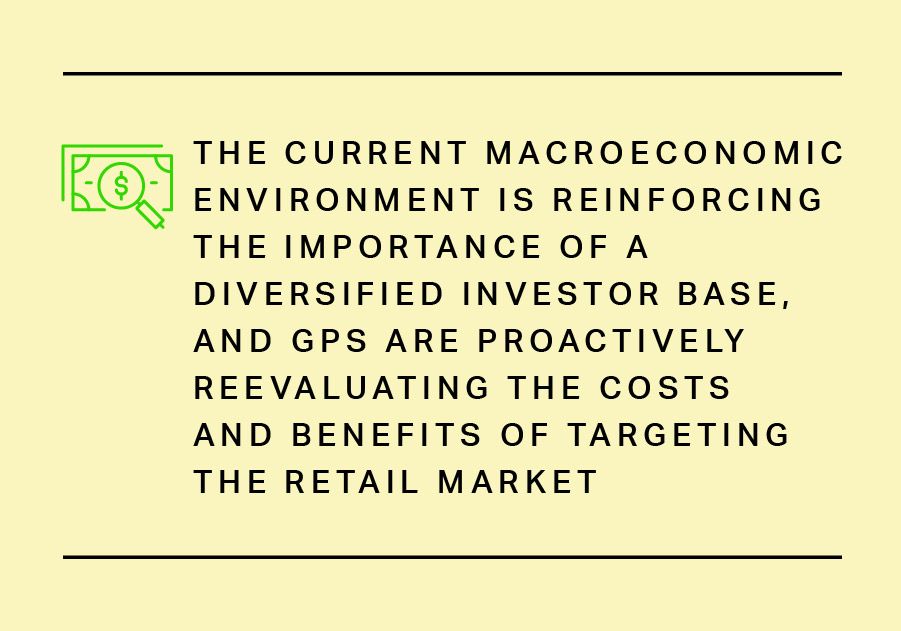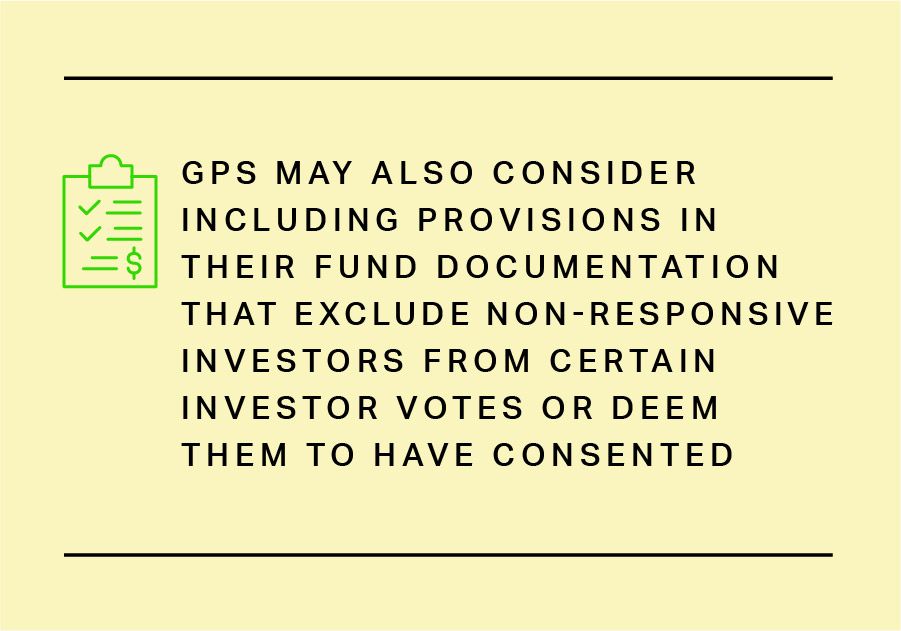The Democratization
of Private Markets:
Know Your Options

Calls for the democratization of private markets have grown steadily over recent years, as vast swaths of the investor universe, from the mass affluent to 401(k) pension plans, have effectively been barred from asset classes that offer uncorrelated and often superior returns and as the number of public companies continues to dwindle. Meanwhile, some of the industry’s biggest and best-known private fund sponsors (“GPs”), many of which are now listed themselves, have begun to tap into this vast pool of capital in their quest to grow AUM.
The proliferation of products targeting the mass affluent and high net worth individuals (“HNWIs”) is gaining momentum. In an environment where institutional investors were clamoring for access to funds, the accepted wisdom was that a $200mn commitment from a pension plan required dramatically less resources to onboard and manage than hundreds or thousands of smaller commitments totaling the same amount.
However, a confluence of structural and technological innovations capable of easing the administrative burden, coupled with the denominator effect that is hitting many institutional investors, means that many GPs are now actively exploring how best to target a potentially transformative new group of investors.
The proliferation of products targeting the mass affluent and high net worth individuals (“HNWIs”) is gaining momentum. In an environment where institutional investors were clamoring for access to funds, the accepted wisdom was that a $200mn commitment from a pension plan required dramatically less resources to onboard and manage than hundreds or thousands of smaller commitments totaling the same amount.
However, a confluence of structural and technological innovations capable of easing the administrative burden, coupled with the denominator effect that is hitting many institutional investors, means that many GPs are now actively exploring how best to target a potentially transformative new group of investors.

$200Mn
The accepted wisdom was that a $200mn commitment from a pension plan required dramatically less resources to onboard and manage than hundreds or thousands of smaller commitments totaling the same amount

Retail Versus Institutional Investors
Democratization is not a fundraising panacea, of course. Although HNWIs may wish to increase their exposure to alternative assets and are not subject to the same allocation restrictions as some institutional investors, a lack of distributions as exits slow means many HNWIs may currently have a similar limited capacity for new commitments.
Nonetheless, the current macroeconomic environment is reinforcing the importance of a diversified investor base, and GPs are proactively reevaluating the costs and benefits of targeting the retail market.
GPs considering this course of action will first need to decide whether they want to create an in-house program to directly target affluent investors, hire a placement agent to market one or more funds to individual investors or partner with one or more banks and administrators that will form their own conduit funds to raise capital from their customer base.
Running an in-house program requires a substantial allocation of resources in the form of a distribution network, regulatory expertise and internal legal and sales staff. The benefit, meanwhile, is that the GP really owns those relationships and consequently can build greater investor loyalty. Working with a bank or other placement agent, conversely, will alleviate pressure on resources but may limit the GP’s ability to develop relationships with the underlying investors. It will also come at the cost of a placement fee that will typically reduce the amount of management fees received by the fund’s manager.
GPs that intend to accept smaller investor commitments may want to consider implementing some form of surcharge for smaller tickets to offset the additional administrative cost resulting from managing many individual commitments over the life of the fund.
GPs may also consider including provisions in their fund documentation that exclude non-responsive investors from certain investor votes or deem them to have consented, as smaller investors may be less responsive than institutional investors, particularly later in the life of the fund.
Retail Versus Institutional Investors
Democratization is not a fundraising panacea, of course. Although HNWIs may wish to increase their exposure to alternative assets and are not subject to the same allocation restrictions as some institutional investors, a lack of distributions as exits slow means many HNWIs may currently have a similar limited capacity for new commitments.
Nonetheless, the current macroeconomic environment is reinforcing the importance of a diversified investor base, and GPs are proactively reevaluating the costs and benefits of targeting the retail market.


GPs considering this course of action will first need to decide whether they want to create an in-house program to directly target affluent investors, hire a placement agent to market one or more funds to individual investors or partner with one or more banks and administrators that will form their own conduit funds to raise capital from their customer base.
Running an in-house program requires a substantial allocation of resources in the form of a distribution network, regulatory expertise and internal legal and sales staff. The benefit, meanwhile, is that the GP really owns those relationships and consequently can build greater investor loyalty. Working with a bank or other placement agent, conversely, will alleviate pressure on resources but may limit the GP’s ability to develop relationships with the underlying investors. It will also come at the cost of a placement fee that will typically reduce the amount of management fees received by the fund’s manager.
GPs that intend to accept smaller investor commitments may want to consider implementing some form of surcharge for smaller tickets to offset the additional administrative cost resulting from managing many individual commitments over the life of the fund.
GPs may also consider including provisions in their fund documentation that exclude non-responsive investors from certain investor votes or deem them to have consented, as smaller investors may be less responsive than institutional investors, particularly later in the life of the fund.


Technology, Regulation and Innovative Investment Vehicles

Technology is likely to prove critical to the democratization of private markets in many ways. For example, electronic subscription documentation could prove transformative, while dedicated platforms providing automated reporting and other tech solutions, such as iCapital and Moonfare, have been vital to easing investor onboarding and maintenance1.
Regulation, however, is an important aspect to consider in the context of any democratization plan. “Democratization” can cover investors of many shapes and sizes, from true retail investors to those that meet the “accredited investor” and/or “qualified purchaser” sophistication requirements, who may have a level of private markets understanding and sophistication to rival institutions. As a result of regulatory requirements, private fund GPs seeking to increase their retail investor base often remain focused on those that meet the accredited investor and qualified purchaser thresholds.
There have been suggestions that blockchain tokenization technology could help eliminate much of the friction involved in administering funds with many smaller investors by reducing the effort that goes into buying and selling funds. This technology, however, has yet to become widely adopted, in large part due to regulatory challenges posed by tokenization, such as ensuring that private fund interests are only offered to suitable investors and that the GP is complying with applicable anti-money laundering laws.
Technology, Regulation and Innovative Investment Vehicles

Technology is likely to prove critical to the democratization of private markets in many ways. For example, electronic subscription documentation could prove transformative, while dedicated platforms providing automated reporting and other tech solutions, such as iCapital and Moonfare, have been vital to easing investor onboarding and maintenance1.
Regulation, however, is an important aspect to consider in the context of any democratization plan. “Democratization” can cover investors of many shapes and sizes, from true retail investors to those that meet the “accredited investor” and/or “qualified purchaser” sophistication requirements, who may have a level of private markets understanding and sophistication to rival institutions. As a result of regulatory requirements, private fund GPs seeking to increase their retail investor base often remain focused on those that meet the accredited investor and qualified purchaser thresholds.
There have been suggestions that blockchain tokenization technology could help eliminate much of the friction involved in administering funds with many smaller investors by reducing the effort that goes into buying and selling funds. This technology, however, has yet to become widely adopted, in large part due to regulatory challenges posed by tokenization, such as ensuring that private fund interests are only offered to suitable investors and that the GP is complying with applicable anti-money laundering laws.
Alternative Structures
GPs have also explored the use of other investment vehicle structures, such as private business development companies (“BDCs”), interval funds and real estate investment trusts (“REITs”), that permit greater access to retail investors, including in some instances those that do not meet the accredited investor requirements. Initially, such products were primarily focused on real estate strategies, but recently have become more popular in the private credit space. In general, these products may be more suitable to alternative asset strategies that seek to generate returns based in whole or part on fixed-income investments and investments with greater liquidity than traditional private equity investments.
Private fund GPs considering such structures should first understand the applicable regulatory framework, as these products are subject to significantly greater restrictions and requirements than their private fund counterparts. For example, GPs should note that it could take 18 months or more to launch a private BDC, including state-by-state blue sky filings. Although this market has immense potential if successfully unlocked, it may only be economical for GPs that can scale up quickly.

Alternative Structures
GPs have also explored the use of other investment vehicle structures, such as private business development companies (“BDCs”), interval funds and real estate investment trusts (“REITs”), that permit greater access to retail investors, including in some instances those that do not meet the accredited investor requirements. Initially, such products were primarily focused on real estate strategies, but recently have become more popular in the private credit space. In general, these products may be more suitable to alternative asset strategies that seek to generate returns based in whole or part on fixed-income investments and investments with greater liquidity than traditional private equity investments.
Private fund GPs considering such structures should first understand the applicable regulatory framework, as these products are subject to significantly greater restrictions and requirements than their private fund counterparts. For example, GPs should note that it could take 18 months or more to launch a private BDC, including state-by-state blue sky filings. Although this market has immense potential if successfully unlocked, it may only be economical for GPs that can scale up quickly.
One Eye on Regulation

Democratization will only draw additional attention from regulators, many of whom are already keenly focused on private markets.
Indeed, while the continued democratization of private markets seems inevitable given the immense growth of the private investment industry and the universe of alternative assets, GPs should tread carefully and enlist the help of legal counsel in navigating these new opportunities.


